Legio XI Claudia Pia Fidelis
Legio XI Claudia Pia Fidelis: one of the Roman legions. Its name means "the legion that is loyal and faithful to Claudius".
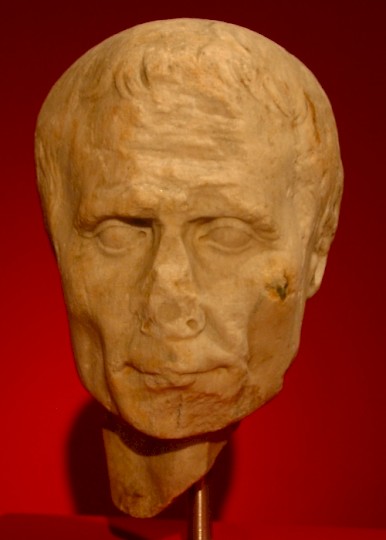
The Eleventh and Twelfth legions were recruited by the Roman general Julius Caesar for the campaign against the Helvetians in 58 BCE. Caesar also mentions this unit in his account of the battle against the Nervians, which took place in the late summer of 57. This unit must have been present at the other famous campaigns as well, such as the sieges of Bourges and Alesia.
During the civil war against Caesar's fellow-triumvir and rival Pompey the Great, which broke out in January 49, the Eleventh took part in Caesar's invasion of Italy and stayed in Apulia for some time. In the spring of 48, it fought at Dyrrhachium. It was present in the battle of Pharsalus (9 August 48) and was disbanded in 45. The veterans were settled at Bovianum in Central-Italy.

In 42, however, this legion was reconstituted by Caesar's heir Octavian. After it had fought for the members of the Second Triumvirate and against the assassins of Caesar, Brutus and Cassius, in the battle of Philippi, the unit went back to Italy and suppressed a rebellion at Perugia. Probably, it also fought in Octavian's campaigns against Sextus Pompeius, the son of Caesar's rival Pompey the Great, who had occupied Sicily and threatened the food supply of Rome. He was defeated by Octavian's general Marcus Vipsanius Agrippa.
Perhaps the Eleventh earned a surname at this stage (the Tenth was henceforth known as Fretensis), but we don't know what this name may have been. Surnames appear to have been rare at this moment anyhow, so we need not be surprised.
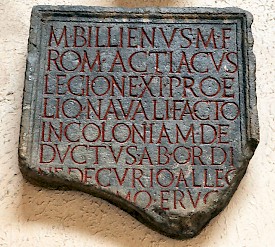
In 32, Octavian and his fellow-triumvir Mark Antony started a war, which culminated in the naval battle off Actium (31), where Octavian defeated his opponent and won the supremacy in the Mediterranean world. The eleventh legion seems to have fought bravely, and veterans commemorated on their tombstones that they had fought over there. From now on, Octavian was sole ruler of the Roman world and known as the emperor Augustus.
The Eleventh was now sent to the Balkans, where it stayed for almost a century. Its original base is not known, but after the reshuffling of the Roman forces after the disaster in the Teutoburg Forest (September 9 CE), the legion was staying on the Dalmatian coast at Burnum (modern Kistanje), which it occupied together with the Seventh Legion. The soldiers of the eleventh legion must have been employed on several places, such as the provincial capital Salonae, modern Split. A subunit stayed at Trilj-Gardun, and other legionaries built new roads, opening the interior for economic development
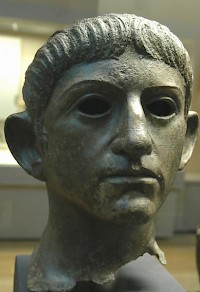
It was still at Burnum when in 42 the governor of Dalmatia, Lucius Arruntius Camillus Scribonianus, revolted against the emperor Claudius, who had recently come to power. The soldiers of the Seventh and Eleventh, however, immediately put an end to this rebellion. They were awarded the honorary title Claudia Pia Fidelis, loyal and faithful to Claudius.
In c.58, VII Claudia left Burnum, to be redeployed at the Danube. Its twin, our eleventh legion, remained on the Dalmatian coast, where it is mentioned at the time of the emperor Nero's suicide in the summer of 68.
The official new emperor was an old man named Galba, who got into troubles in January 69, when the commander of the army of Germania Inferior, Vitellius, revolted, and a rich senator named Otho declared himself emperor too. Galba was lynched on the Forum and every legion had to choose between Otho and Vitellius. With the Seventh and Fourteenth, our unit sided with Otho. A large subunit was sent to fight against Vitellius at Cremona, but was unable to prevent his victory - the soldiers arrived too late for the battle. The new emperor Vitellius, however, did not punish them and merely ordered their return to Dalmatia.
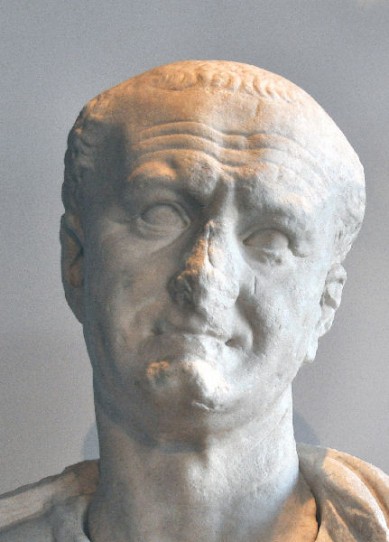
The legion now sided with Vespasian, and was among the victors after the second battle of Cremona (October 69). In 70, it was part of the expeditionary force of general Cerialis, who suppressed the Batavian revolt. Having achieved this aim, the legion was sent to the old base of XXI Rapax, Vindonissa (modern Windisch) in Germania Superior. In Dalmatia, the Eleventh was replaced by IIII Flavia Felix.
There is much archaeological evidence for the legion's stay at Windisch, including the discovery of its kilns at Rupperswil, and several minor posts along the road towards the Alps. The soldiers were also active in construction work at modern Baden-Baden. The Eleventh fought on the eastern bank of the Rhine in 73/74, and in 83, they took part in the war against the Chatti led by Domitian. Its must have stayed at Mainz, in peacetime the base of I Adiutrix and XIV Gemina.
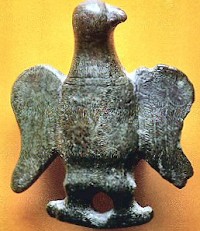
In 101, thirty years after its arrival at Windisch, it was sent to Brigetio (Szöny) in Pannonia Inferior. From here, it must have taken part in Trajan's invasion of Dacia (101-106), which was commemorated with the famous Column of Trajan in Rome.
Before 114, the eleventh, Claudian legion was transferred to Durostorum in Moesia Inferior, modern-day Silistra near the delta of the Danube. Here, the unit was to stay for three or four centuries. Its recruits increasingly were young men from nearby Thrace.
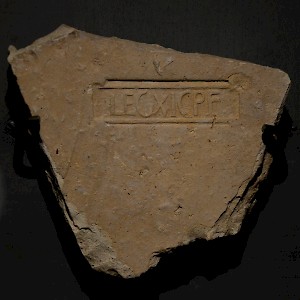
One of its tasks was the occupation of the Crimea, where several Greek towns were protected by Roman units. The Moesian legions were by turn responsible for this outpost. Several inscriptions attest the presence of soldiers of XI Claudia, I Italica and V Macedonica. Among the legion's other activities were the construction of a fort at Draschna in the valley of the Buzau in the southeastern Carpates (done with V Macedonica), and bureaucratic tasks at the provincial capital, Tomis.
During the reign of Hadrian, a subunit of the eleventh legion was sent Judaea, to suppress the messianic revolt of Simon ben Kosiba (132-136), one of the most difficult wars Rome ever fought.
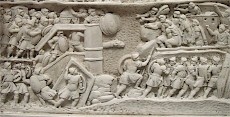
When the governor of Pannonia Superior, Lucius Septimius Severus, was proclaimed emperor in April 193, the Eleventh immediately joined his cause. In a lightning campaign he marched on Rome, but our unit dod not take part, because Durostorum was too far from Italy. However, it played a role in Severus' next campaign, against his eastern rival Pescennius Niger. The soldiers of I Italica and XI Claudia besieged Byzantium, forced the Cilician gate, and fought at Issus. It is likely that they also took part in Severus' campaigns against the Parthian empire, which culminated in the capture of Ctesiphon (198).
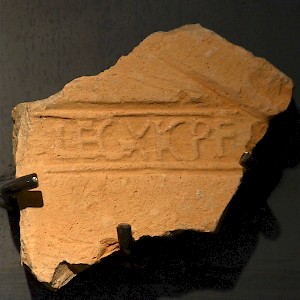
During the conflict between the emperor Gallienus (260-268) and his rival Postumus of the Gallic Empire, the eleventh legion supported the first-mentioned, for which it was rewarded with surnames like Pia V Fidelis V (five times faithful and loyal) and Pia VI Fidelis VI. Other units were considered to have been seven times faithful & loyal, but not the Eleventh. We don't know why its loyalty and faithfulness were recognized only six, not seven times. Nor do we know which emperor praised these qualities for the second, third and fourth time.
In 273, soldiers of this unit (and four other legions) were involved in road building activity in Jordan, as is attested in an inscription from Qasr el-Azraq. In 295, a mobile subunit of the eleventh legion fought in Egypt, and three years later, another subunit fought in Mauretania. In 302, a member of the Claudian legion named Julius was tortured to death at Durostorum, because he was a Christian. A man named Hesychius was the next legionary to be killed, for identical reasons.
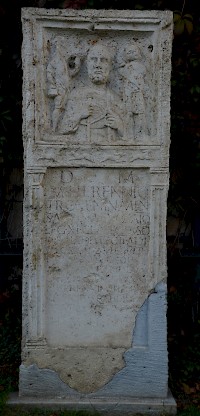
In the early fifth century, the eleventh, Claudian legion was still guarding the Lower Danube at Durostorum. What happened later, is not known.
Since this legion was constituted by Caesar, its emblem may have been a bull, but this symbol is nowhere to be found. Instead, the soldiers may have worn badges showing the sea god Neptune. An alternative emblem may have been the she-wolf with the twins Romulus and Remus.
Liteature
- R. Fellmann, "Die 11. Legion Claudia Pia Fidelis", in: Yann Le Bohec, Les légions de Rome sous le Haut-Empire (2000 Lyon) 127-131